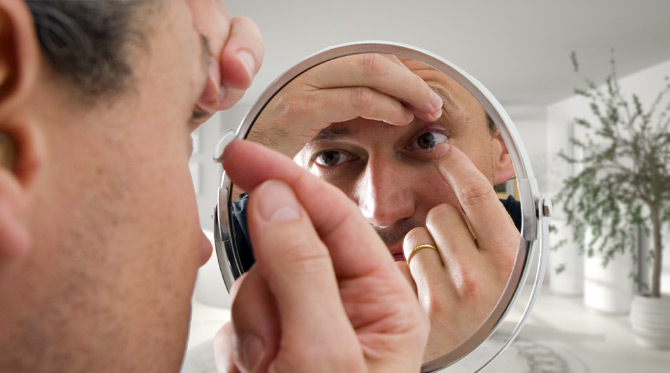| |
We only offer the best in contact lens
technology to
provide
you
with optimal vision, comfort and health. |
We have contacts available to target
specific eye problems like dry eyes, astigmatism, difficulty
reading, and eye diseases like keratoconus. We are focused on giving you the best comfort and vision, not just adequate
comfort and vision. Contacts are constantly being improved for
more comfort and better vision. |
| |
 |
| |
| What are the different types of Contact Lenses? |
| |
Soft Contact Lenses
Soft contact lenses are made of soft, flexible plastics that allow
oxygen to pass through to the cornea. Soft contact lenses may be
easier to adjust to and are more comfortable than rigid gas
permeable lenses. Newer soft lens materials include silicone-hydrogels
to provide more oxygen to your eye while you wear your lenses. |
| |
Rigid Gas Permeable (RGP) Contact Lenses
Rigid gas permeable contact lenses (RGPs) are more
durable and resistant to deposit buildup. They tend to be
less expensive over the life of the lens since they last
longer than soft contact lenses. They are easier to handle
and less likely to tear. However, they are not as
comfortable initially as soft contacts and it may take a few
weeks to get used to wearing RGPs, compared to several days
for soft contacts. |
| |
Continuous Wear Contact Lenses
Continuous wear contact lenses are available for overnight or
continuous wear ranging from one to six nights.
Continuous wear contact lenses are usually soft contact lenses. They
are made of flexible plastics that allow oxygen to pass through to
the cornea. There are also a very few rigid gas permeable lenses
that are designed and approved for overnight wear. Length of
continuous wear depends on lens type and your eye care
professional's evaluation of your tolerance for overnight wear. It is
important for the eyes to have a rest without lenses for at least
one night following each scheduled removal. |
| |
Disposable (Replacement Schedule) Contact
Lenses
The majority of soft contact lens wearers are prescribed some
type of frequent replacement schedule. "Disposable," as defined by
the FDA, means used once and discarded. With a true daily wear
disposable schedule, a brand new pair of lenses is used each day.
Some soft contact lenses are referred to as "disposable" by contact
lens sellers, but actually, they are for frequent/planned
replacement. With extended wear lenses, the lenses may be worn
continuously for the prescribed wearing period (for example, 7 days
to 30 days) and then thrown away. When you remove your lenses, make
sure to clean and disinfect them properly before reinserting. |
| |
Hybrid Contact
Lenses
The hybrid contact lens combines a rigid gas permeable center and a
soft lens skirt into one unique "hybrid" lens. The rigid
center corrects farsightedness, nearsightedness and
astigmatism and delivers clear, high definition vision, even
at night. The soft skirt surrounding the center provides
the all-day comfort of a soft lens. |
| |
Orthokeratology (Ortho-K)
Orthokeratology, or Ortho-K, is a lens fitting procedure that
uses designed rigid gas permeable (RGP) contact lenses to
change the curvature of the cornea to temporarily improve the eye's
ability to focus on objects. This procedure is primarily used for
the correction of myopia (nearsightedness).
Overnight Ortho-K lenses are the most common type of Ortho-K. There
are some Ortho-K lenses that are prescribed only for daytime wear.
Overnight Ortho-K lenses are commonly prescribed to be worn while
sleeping for at least eight hours each night. They are removed upon
awakening and not worn during the day. Some people can go all day
without their glasses or contact lenses. Others will find that their
vision correction will wear off during the day.
The vision correction effect is temporary. If Ortho-K is
discontinued, the corneas will return to their original curvature
and the eye to its original amount of nearsightedness. Ortho-K
lenses must continue to be worn every night or on some other
prescribed maintenance schedule in order to maintain the treatment
effect. Your eye care professional will determine the best
maintenance schedule for you. |
| |
Decorative (Plano) Contact Lenses
Some contact lenses do not correct vision and are intended
solely to change the appearance of the eye. These are sometimes
called plano, zero-powered or non-corrective lenses. For example,
they can temporarily change a brown-eyed person's eye color to blues.
Even though these decorative lenses don't correct vision, they're
regulated by the FDA, just like corrective contact lenses. |
|
Scleral Contact Lenses
Scleral lenses are larger lenses made of gas permeable
material used to correct vision in a number of conditions
such as keratoconus, post-refractive surgery corneal issues,
ocular surface disease, dry eye, and even normal refractive
errors. |
| |
Prosthetic Contact Lenses
Prosthetic lenses are used to achieve an improved
cosmetic appearance when an eye has a misshaped pupil. If
two eyes appear different due to a pupil irregularity,
prosthetic lenses can be designed to match the iris of the
other eye. |
| |